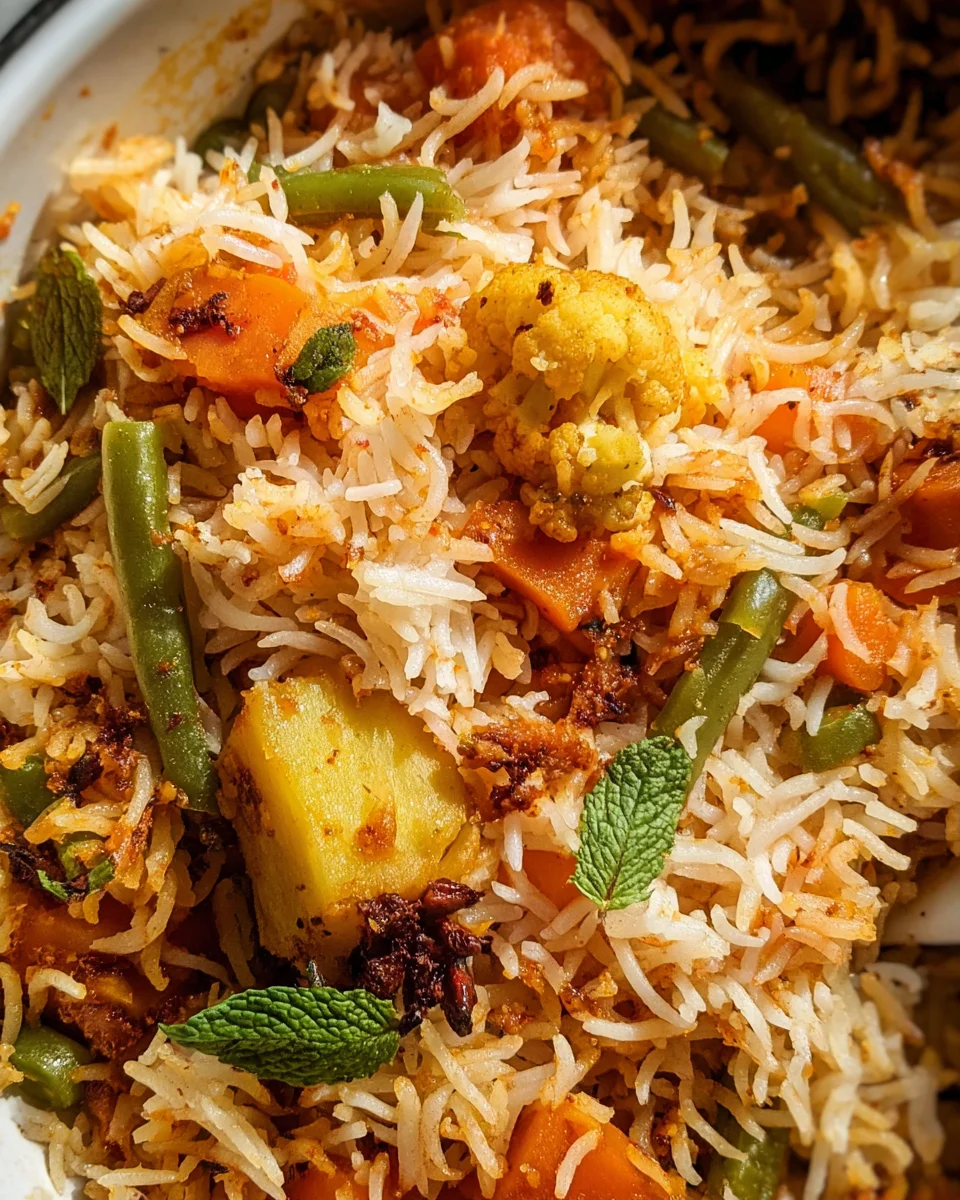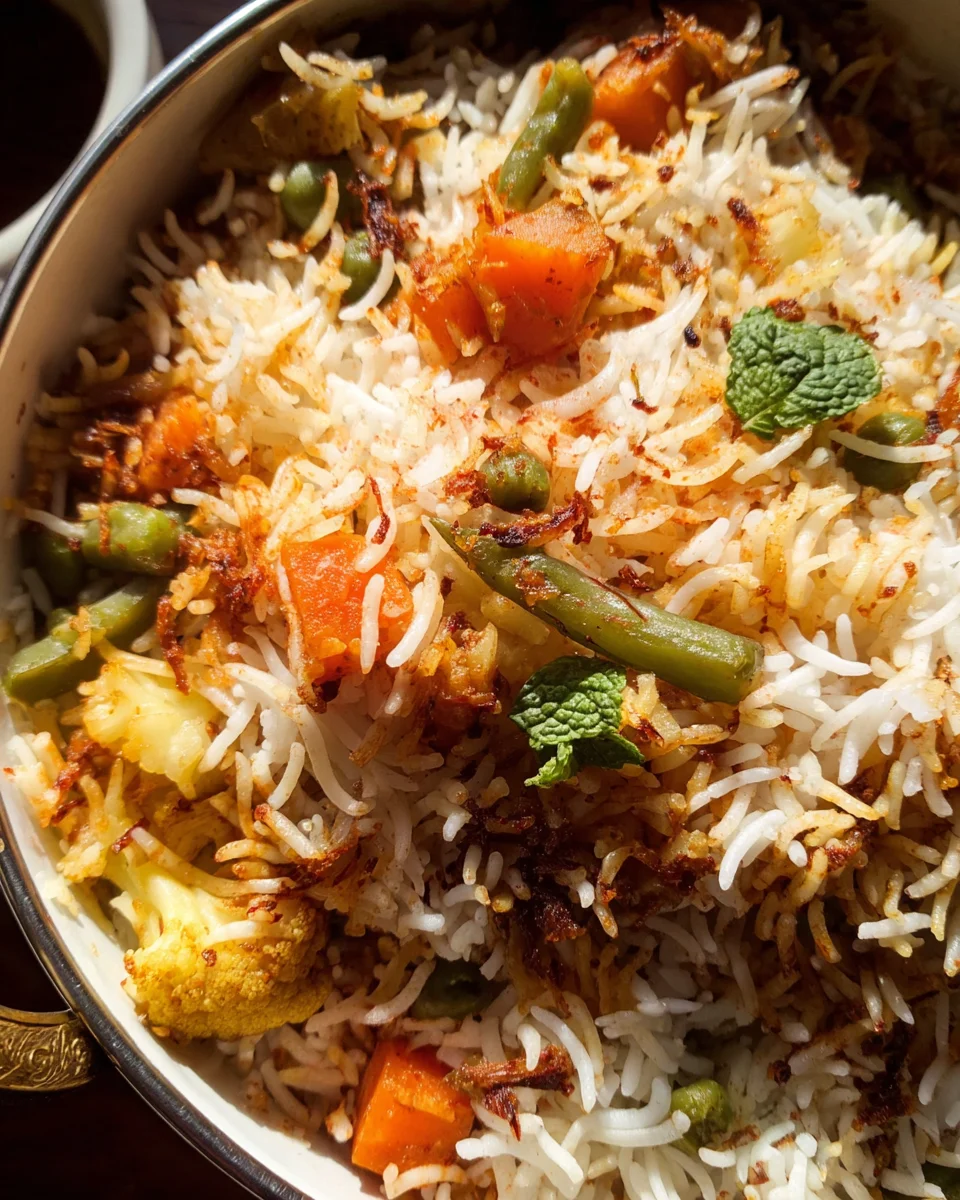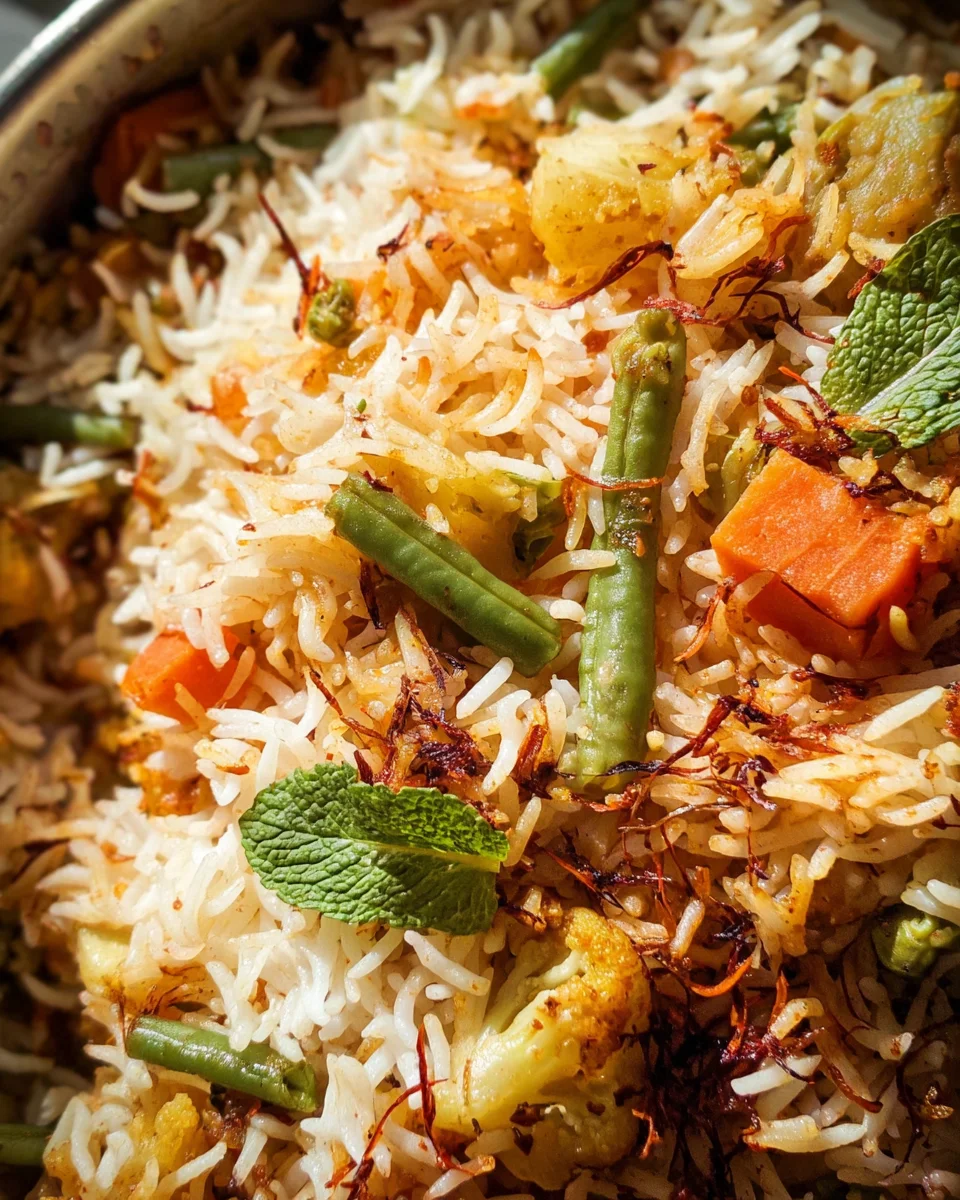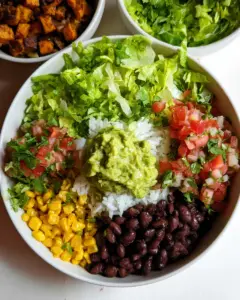Aromatic and flavorful restaurant style Vegetable Biryani is a delightful dish that brings a taste of India into your home. This vibrant biryani combines a variety of fresh vegetables, aromatic spices, and fragrant basmati rice, making it perfect for family dinners, special occasions, or meal prep. With its rich flavors and colorful presentation, this dish stands out as a centerpiece for any table.

Jump to:
- Why You’ll Love This Recipe
- Tools and Preparation
- Essential Tools and Equipment
- Importance of Each Tool
- Ingredients
- For the Rice
- For the Vegetables
- For the Spices & Flavor Enhancers
- For Creaminess & Aroma
- For Garnish & Finishing Touches
- How to Make Restaurant Style Vegetable Biryani
- Step 1: Prepare the Rice
- Step 2: Cook the Spices
- Step 3: Sauté Onions & Vegetables
- Step 4: Mix Yogurt & Spices
- Step 5: Layer & Cook
- Step 6: Finish with Herbs & Aromas
- How to Serve Restaurant Style Vegetable Biryani
- With Raita
- Accompanied by Salads
- Garnished with Fresh Herbs
- With Pickles
- How to Perfect Restaurant Style Vegetable Biryani
- Best Side Dishes for Restaurant Style Vegetable Biryani
- Common Mistakes to Avoid
- Storage & Reheating Instructions
- Refrigerator Storage
- Freezing Restaurant Style Vegetable Biryani
- Reheating Restaurant Style Vegetable Biryani
- Frequently Asked Questions
- How do I achieve the best flavor in Restaurant Style Vegetable Biryani?
- Can I make Restaurant Style Vegetable Biryani vegan?
- What vegetables work best in this biryani?
- How long does Restaurant Style Vegetable Biryani last?
- Final Thoughts
- 📖 Recipe Card
Why You’ll Love This Recipe
- Delicious Flavor Explosion: Each bite offers a burst of spices and herbs that tantalize your taste buds.
- Vegetable-Packed Goodness: Full of nutritious vegetables, this biryani is both satisfying and healthy.
- Easy to Customize: You can easily swap vegetables or adjust spices to suit your preferences.
- Perfect for Any Occasion: Whether it’s a casual family meal or a festive gathering, this dish fits right in.
- One-Pot Wonder: Minimal cleanup with all ingredients cooked together in one pot.
Tools and Preparation
To make the best restaurant style Vegetable Biryani, having the right tools will streamline your cooking process and ensure great results.
Essential Tools and Equipment
- Heavy-bottomed pot or Dutch oven
- Ladle or spatula
- Measuring cups and spoons
- Knife and chopping board
Importance of Each Tool
- Heavy-bottomed pot or Dutch oven: Ensures even cooking and prevents the rice from burning.
- Ladle or spatula: Ideal for gently stirring without breaking the veggies or rice.
- Measuring cups and spoons: Accurate measurements help maintain the balance of flavors.
- Knife and chopping board: Essential for preparing fresh ingredients quickly and safely.
Ingredients
Aromatic and flavorful restaurant style Vegetable Biryani! This fragrant biryani is packed with veggies, spices, herbs, and nuts and is an explosion of flavors in every bite!
For the Rice
- 1 cup basmati rice (200 grams, soaked in 3 cups (24 oz) water for 30 minutes)
- 6 whole green cardamom (divided)
- 4 cloves (divided)
- 1 teaspoon salt (divided)
- 1.5 tablespoon + 1 teaspoon ghee (divided)
For the Vegetables
- 2 medium red onion (thinly sliced, divided)
- 2 tablespoons broken cashews
- 1 small potato (cubed)
- 1/2 cup cauliflower florets (medium-sized florets)
- 1 medium carrot (cut diagonally)
- 5-6 green beans (cut diagonally)
For the Spices & Flavor Enhancers
- 2 tablespoons milk (30 ml)
- Saffron strands (generous pinch)
- 1 inch ginger (crushed)
- 4-5 large garlic cloves (crushed)
- 2 green chilies (crushed)
- 1.5 tablespoons oil (22 ml)
- 1/2 teaspoon cumin seeds (I used shahi jeera)
- 1 inch cinnamon stick
- 1 bay leaf
- 3 whole black peppercorns
For Creaminess & Aroma
- 1/3 cup plain yogurt (whisked and at room temperature; can add 1/4 teaspoon cornstarch to prevent curdling)
- 1.5 teaspoon biryani masala (or use 1 teaspoon garam masala)
- 1/2 teaspoon kashmiri red chili powder (or use regular chili powder for heat)
For Garnish & Finishing Touches
- 1/4 cup water
- 2 tablespoons chopped cilantro
- 2 tablespoons chopped mint
- 1.5 teaspoon rose water or kewra water
How to Make Restaurant Style Vegetable Biryani
Step 1: Prepare the Rice
Soak the basmati rice in water for 30 minutes before cooking. This helps achieve fluffy grains.
Step 2: Cook the Spices
In a heavy-bottomed pot, heat oil over medium heat. Add in half of the cardamom pods, cloves, cumin seeds, cinnamon stick, bay leaf, and black peppercorns. Sauté until fragrant.
Step 3: Sauté Onions & Vegetables
Add sliced onions to the pot. Cook until golden brown. Then add cubed potatoes, cauliflower florets, carrot slices, and green beans. Stir well.
Step 4: Mix Yogurt & Spices
In a bowl, mix whisked yogurt with ginger, garlic, green chilies, biryani masala, salt, kashmiri red chili powder, saffron soaked in milk, and remaining spices. Combine thoroughly.
Step 5: Layer & Cook
Layer the sautéed vegetables with soaked rice in the pot. Pour water over it all. Cover tightly with a lid. Cook on low heat for about 25-30 minutes until rice is fluffy.
Step 6: Finish with Herbs & Aromas
Once cooked, turn off the heat. Gently fluff the biryani with a fork. Add chopped cilantro, mint leaves, ghee if desired, along with rose water or kewra water for added fragrance.
This restaurant style Vegetable Biryani is sure to impress your guests while being simple enough for a weeknight dinner! Enjoy!
How to Serve Restaurant Style Vegetable Biryani
Serving Restaurant Style Vegetable Biryani is an art in itself. The way you present this dish can enhance its appeal and flavor experience. Here are some delightful serving suggestions to elevate your biryani.
With Raita
- Cucumber Raita: A refreshing yogurt-based side that balances the spices of the biryani.
- Boondi Raita: Crispy, tiny fried chickpea flour balls mixed in yogurt for added texture.
Accompanied by Salads
- Kachumber Salad: A mix of diced cucumber, tomatoes, and onions with a splash of lemon juice for freshness.
- Onion Salad: Sliced onions with a sprinkle of salt and lime juice to complement the flavors.
Garnished with Fresh Herbs
- Chopped Cilantro: Sprinkling fresh cilantro enhances aroma and adds a pop of color.
- Mint Leaves: Fresh mint leaves can elevate the taste and add a refreshing touch.
With Pickles
- Mango Pickle: A tangy mango pickle brings an exciting contrast to the dish.
- Mixed Vegetable Pickle: Adds a spicy kick, making each bite even more flavorful.

How to Perfect Restaurant Style Vegetable Biryani
To achieve the best results with your Restaurant Style Vegetable Biryani, consider these useful tips that will enhance both flavor and presentation.
- Use High-Quality Rice: Opt for aged basmati rice for better texture and aroma.
- Soak the Rice: Soaking rice before cooking helps it cook evenly and remain fluffy.
- Layer Ingredients Thoughtfully: Alternate layers of rice and vegetables to ensure flavors meld beautifully.
- Rest After Cooking: Allow the biryani to sit covered for 10-15 minutes after cooking; this helps flavors develop further.
- Garnish Generously: Use fried onions, nuts, and fresh herbs as garnish for added flavor and visual appeal.
- Serve Hot: Enjoy your biryani warm to appreciate all its aromatic qualities.
Best Side Dishes for Restaurant Style Vegetable Biryani
Pairing your Restaurant Style Vegetable Biryani with the right side dishes can elevate your meal experience. Here are some excellent options to consider.
- Papadum: Crunchy lentil wafers that add a delightful crunch alongside biryani.
- Dal Makhani: Creamy black lentils that complement the spices beautifully.
- Vegetable Curry: A mild curry made with seasonal vegetables enriches your meal without overpowering it.
- Paneer Tikka: Grilled marinated paneer cubes offer a smoky flavor that works well with biryani.
- Chutney Platter: A variety of chutneys (mint, tamarind) provides different tastes to explore with each bite.
- Samosas: Crispy potato-filled pastries make for a hearty side that pairs well with biryani’s flavors.
- Methi Thepla: These spiced flatbreads add an aromatic touch that complements the main dish nicely.
- Masala Chaas (Spiced Buttermilk): A cooling drink that aids digestion while enhancing the overall dining experience.
Common Mistakes to Avoid
Making restaurant style Vegetable Biryani can be a delightful experience, but it’s easy to make mistakes. Here are some common pitfalls to watch out for.
- Using non-basmati rice – Basmati rice offers the best texture and aroma for biryani. Avoid using other types, as they can turn mushy.
- Skipping the soaking process – Soaking basmati rice is crucial for the perfect texture. It helps the grains elongate and prevents them from breaking during cooking.
- Overcooking vegetables – To maintain crunchiness and flavor, add vegetables at the right time. Cook them just until tender but not mushy.
- Neglecting spices – Spices are key to a flavorful biryani. Ensure you use fresh and adequate amounts of spices for the best taste.
- Not layering properly – Layering is essential in biryani preparation. Alternate rice and vegetable layers for even distribution of flavors.

Storage & Reheating Instructions
Refrigerator Storage
- Store leftover vegetable biryani in an airtight container.
- It will stay fresh in the fridge for up to 3 days.
Freezing Restaurant Style Vegetable Biryani
- Place cooled biryani in freezer-safe containers or bags.
- It can be frozen for up to 2 months.
Reheating Restaurant Style Vegetable Biryani
- Oven – Preheat to 350°F (175°C) and cover with foil to retain moisture while reheating.
- Microwave – Heat in short intervals, stirring occasionally to ensure even warming.
- Stovetop – Add a splash of water, cover, and heat on low until warmed through.
Frequently Asked Questions
Here are some common questions about making restaurant style Vegetable Biryani.
How do I achieve the best flavor in Restaurant Style Vegetable Biryani?
Using fresh spices, herbs, and quality ghee will enhance the flavor significantly. Don’t rush the cooking process; allow the ingredients to meld together for a rich taste.
Can I make Restaurant Style Vegetable Biryani vegan?
Yes! Simply substitute ghee with oil and use plant-based yogurt or omit it altogether. The dish will still be delicious without compromising on flavor.
What vegetables work best in this biryani?
You can use carrots, peas, potatoes, cauliflower, and green beans. Feel free to mix your favorites for a personalized touch!
How long does Restaurant Style Vegetable Biryani last?
When stored properly in the refrigerator, it lasts up to 3 days. If frozen, it can stay good for about 2 months.
Final Thoughts
This restaurant style Vegetable Biryani is not only aromatic but also incredibly versatile. You can customize it with your favorite vegetables or spices based on your preferences. Give this recipe a try; it’s sure to impress your family and friends!
Did You Enjoy Making This Recipe? Please rate this recipe with ⭐⭐⭐⭐⭐ or leave a comment.
📖 Recipe Card
Print
Restaurant Style Vegetable Biryani
- Total Time: 45 minutes
- Yield: Serves 4
Description
Experience the vibrant flavors of India with our Restaurant Style Vegetable Biryani, a fragrant and colorful dish that combines aromatic basmati rice with an assortment of fresh vegetables and spices. This one-pot wonder is perfect for family gatherings, special occasions, or simply enjoying a comforting meal at home. Each bite is a delightful explosion of taste, making it a showstopper on any dining table.
Ingredients
- 1 cup basmati rice
- 2 medium red onions
- 1 small potato
- 1/2 cup cauliflower florets
- 1 medium carrot
- 5–6 green beans
- saffron
- cumin seeds
- cinnamon stick
- bay leaf
- 1/3 cup plain yogurt
Instructions
- Soak basmati rice in water for 30 minutes.
- In a heavy-bottomed pot, heat oil and sauté half the spices until fragrant.
- Add sliced onions and cook until golden brown. Stir in cubed potatoes and other vegetables; mix well.
- In a bowl, combine whisked yogurt with remaining spices and add to the pot.
- Layer soaked rice over the vegetable mixture, pour water on top, cover tightly, and cook on low heat for 25-30 minutes.
- Once cooked, fluff gently with a fork and garnish with chopped cilantro and mint.
- Prep Time: 15 minutes
- Cook Time: 30 minutes
- Category: Main
- Method: One-Pot
- Cuisine: Indian
Nutrition
- Serving Size: 1 serving
- Calories: 360
- Sugar: 4g
- Sodium: 500mg
- Fat: 12g
- Saturated Fat: 6g
- Unsaturated Fat: 4g
- Trans Fat: 0g
- Carbohydrates: 57g
- Fiber: 5g
- Protein: 10g
- Cholesterol: 15mg





